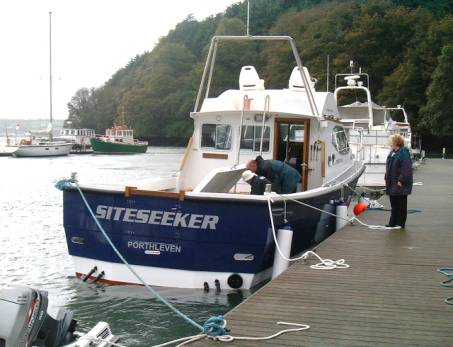
About an hour
previous we had passed a trawler so we decided to try and contact her, which we
did, thankfully. They informed us that the latest weather forecast was 5-7
reaching gale force on Southern Irish coastal waters. As a result of this
news we decided to stop and take stock of the wind and sea condition as it was
now apparent that the weather conditions were much worse than we had expected.
No sooner had we slowed down than the alarm went off on the engine. We stopped
the engine and went to investigate the problem. With the boat now drifting it
immediately became clear how bad conditions were. Drifting beam on, the waves
were breaking over the side of the boat, which gives some example of the
seastate. I was in the engine compartment trying to find the problem, and could
hear the waves breaking
over the boat and crashing onto the engine box lid, which was thankfully,
protecting me.

We
could find no problem with the engine, oil pressure was fine, temperature and
charging were fine yet the alarm was still on. We now had to make the decision
to press on, or head back to Cork. It was clear we had a good force 7 with more
on the way. We would be quite comfortable continuing with a following sea, but
we would have to slow down till it got day light as it would be to dangerous to
run at speed as we couldn’t see the holes that might upset the boat, and
considering the forecast we were looking it
was going to get a whole lot worse with a likely passage time of 15 hrs, and it
was clearly going to be a bad trip. We did feel that we would be ok, but the
engine alarm was worrying. Whilst everything seemed fine, and we felt it was
most likely a faulty sender or alarm, it would have been foolhardy to take the
chance as if the engine did stop we would be in serious trouble. So we made the
decision to turn back for Cork. The moment we put her nose into it we knew we
were in for a beating. Whilst the wave height was at most 8-9 ft they were very
closely spaced, steep and breaking heavily. For the next four hours all Chris
and I could do was stand at the helm and try to see the worst of the waves
coming, which was signalled by the moonlight suddenly reflecting off a mass of
white breaking water appearing above the bow. The boat dealt with all this
brilliantly and all we had to do was set the throttle on 1800rpm, which gave
about 8.5kts and hang on. The autopilot worked a treat and kept us on course but
we were crashing very heavily when we fell off the waves and were shipping them
green over the bow virtually continuously, and not just the odd time. On several
occasions they came right over the bow and up over the flybridge only to dump in
the aft cockpit. I was sure we were going to lose the flybridge seats and
lifebuoys, which were up there. Of as much concern was the anchor which was
gradually getting loosened as a result of the boarding seas, periodically I
would shine a torch on to the bow only to see it rattling around and wonder how
in hell I was going to get up there to secure it if it did get lose. However it
didn’t, and all was fine with us eventually getting home at 7am in the
morning, well battered and tired.
A few things were learnt from all this. Firstly never underestimate the changeable nature of the sea and secondly give the boat a good shakedown before embarking on any serious voyages, Sitseeker had 25hrs on the clock prior to leaving, but this obviously wasn’t enough. It transpired that the alarm went off due to a faulty water level alarm in the header tank, a small fault easily fixed (by unplugging the alarm!!!) and not really a problem. But we weren’t to know that at the time! I think Chris’s words, when we arrived home, “we’re like three little schoolboys sneaking home, after just getting away with, a good telling off from teacher”, sum it all up!